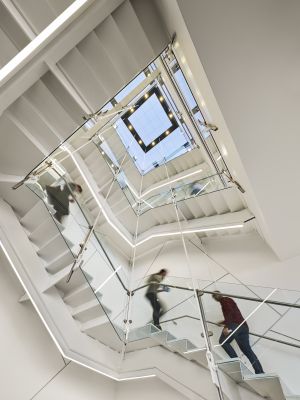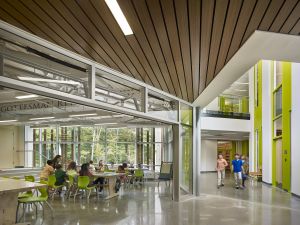At KSS, we believe that big ideas impact design, and that design impacts big ideas. One of these ideas is wellness.
Wellness is the fulfillment of the vast span of our needs. At a basic level,these include air, water, food, clothing, and shelter. And as the capacityof the built environment evolves, we can further fulfill needs likesafety, esteem, belonging, and self-actualization. Connection is at the heart of wellness—connection to self, to others, to nature, and to the world. A successful approach to wellness is one that proactively synthesizes many individual elements, supporting and empowering people and communities toward greatness.
Strategies for Design
We work with our clients to unlock the value of strategies to design for wellness. Together we map out the full array of opportunities to fulfill your needs—whether through boosting employee productivity, advancing student comfort, or empowering users through an integrated approach to wellness. Key considerations include ensuring that ventilation systems circulate fresh air, promoting the use of stairs and walking paths through appealing aesthetics, and improving physical and psychological health through exposure to natural daylight. Great spaces are inspired by nature and incorporate aspects of biophilic design principles, from moments of both prospect and refuge in the built landscape to opportunities for variability and to sensory stimuli—warm wooden finishes, natural colors, and spatially-rich open design.

FITNESS & CONNECTION—BURLINGTON STORES HEADQUARTERS
By employing appealing aesthetics, design can promote the use of stairs and walking paths and discourage the use of elevators. The airy, open stair at Burlington Stores’ corporate headquarters is a space that is strategically located to engage employees and empower them to achieve wellness. With a generous skylight and elegant connective design, the stair is a central presence in a corporate ecosystem where workplace is an interconnected expression of marketplace.

LIGHT & NATURE—GOTTESMAN RTW ACADEMY
At Gottesman RTW Academy, nature and the Judaic concept of tikkun olam—repairing the world—permeate every design decision. The building’s wings are masterfully arranged to resemble the surrounding glacially carved rock masses, tucked gracefully into an existing stand of birch trees. Expanses of glass open the building onto sweeping views of the woods below, yet it remains protected, with wooden slats filtering the light in an aesthetic that evokes daylight sifting through leaves.

COMFORT & VARIABILITY—FERRIS STATE UNIVERSITY CENTER
One of the signature design principles of wellness is comfort—crafting a variety of spaces where occupants can sit or stand, gather together or relax in solitude. At Ferris State’s University Center, the grand staircase opens onto a mélange of study, lounge, and gathering spaces. An intimate fireplace provides refuge from Michigan winters, and the staircase itself is carved out to offer casual gathering areas—a place to see and be seen.
The Value in Building for Wellness
There is overwhelming data indicating that building for wellness pays for itself. For every dollar spent on building operations and maintenance, companies currently spend $10 on employees. And the Harvard Business Review indicates that companies can yield as much as a 600% ROI when it comes to lowering employee health risks. Great design achieves exactly this—with innovative advances in technology and a greater understanding of the implications of building for wellness, organizations have the opportunity to generate immense returns on investment in wellness infrastructure.

